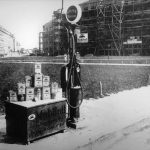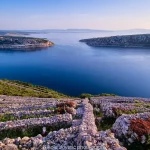Zagreb became a single administrative unit on September 7, 1850!
You probably know that Zagreb wasn’t always a single city, on the contrary, it originated from two separate towns whose inhabitants initially hated each other.
On one side, there was Gradec, a big, walled town inhabited mostly by merchants and craftsmen, and on the other, there was Kaptol, a smaller town where the Cathedral is located and where the clergy used to live.

The oldest depiction of Zagreb, 16th c.
We can trace the origins of Kaptol back to 1094, when King Ladislaus founded the Zagreb diocese. Presumably, there was already a church there at the time, but he expanded it and it was consecrated as a Cathedral in 1217. However, it was badly damaged during the Mongol invasion in 1242, but it was rebuilt in 1263. Fearing the Ottoman invasion, walls were built around it in the 16th c., and you can still see them around the Cathedral. It was severely damaged in the earthquake of 1880, and rebuilt in the Neo-Gothic style, replacing one tower with two 108-metre spires.One section of the wall was torn down in 1907, the one in front of the entrance to the Cathedral.

The Cathedral before the earthquake
One section of the wall was torn down in 1907, the one in front of the entrance to the Cathedral.
Then there was Gradec, the Upper Town. Back in 1242, during the Mongol invasion, King Bela IV decided to offer Gradec a royal charter (Golden Bull), proclaiming it a free royal city, responsible directly to the king, which was a huge thing considering that this was the 13th c.

The Golden Bull
The citizens were granted various rights and liberties, meaning that they could elect their own city magistrate, a role similar to today’s mayor. One of the prerequisites for the charter, however, was building a wall around the city, which is what the citizens did between 1242 and 1261. You can still see the walls, at Strossmayer’s Promenade, for example, but, out of four original gates to the city, there is only one still standing – the Stone Gate.

The Stone Gate, 1864
In addition to the invasions, the two towns went through numerous fires, plague epidemics and earthquakes, and the inhabitants just couldn’t seem to get along – they fought over mills and bridges in Tkalčevićeva Street (which used to be a creek, Medveščak), and the economy.

Medveščak Creek, 1800s
Both cities were prospering, but Gradec residents didn’t think that the self-will of Kaptol’s bishop was fair, so the two towns got to a point where they fought on different sides when a civil war broke out in the 14th c. The disputes continued throughout the 15th and 16th c., and Gradec inhabitants were particularly unhappy with the fact that they had to pay higher taxes and Kaptol had better connections to the Ban and the King.
However, the two cities slowly began to be known simply as Zagreb and not by their separate names and Ban Josip Jelačić finally initiated and Emperor Franz Joseph confirmed their unification in 1850, electing Janko Kamauf, the last city magistrate of Gradec, as the first mayor of Zagreb.

Janko Kamauf
The city started to grow rapidly – the first railway was opened in 1862, numerous cultural institutions were founded, and, after the disastrous earthquake of 1880, additional buildings were renovated, fountains and parks were built, and public transportation was opened, turning Zagreb into the beautiful city of million hearts that we know and love today.
https://www.youtube.com/watch?v=cId1D2teFBw
All photos from Zagreb – kakav je bio nekada, Facebook.








